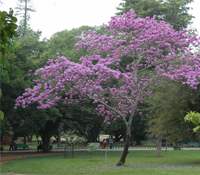 Blow hot...blow cold...blow hot...blow cold. Well, this would most certainly be the conflicting description of Bangalore’s climate as perceived by a motorist passing through the city these days. For the temperature is not uniform at any given point in time. Blow hot...blow cold...blow hot...blow cold. Well, this would most certainly be the conflicting description of Bangalore’s climate as perceived by a motorist passing through the city these days. For the temperature is not uniform at any given point in time.
While some pockets are extremely hot, some areas are cold. So, if you are driving from Indian Institute of Science (IISc) towards Peenya Industrial Estate, the temperature will increase by two degrees Celsius — leaving you with no option other than to increase the AC in your car.
Speaking to Bangalore Mirror, Uttam Kumar, research scholar, Centre for Ecological Sciences, IISc, said: “In the last two decades, Bangalore’s temperature has increased by two degrees, corresponding with an urban growth of 466 per cent.”
GLASS OF THE MATTER
In fact, a study undertaken by Dr T V Ramachandra, Centre for Ecological Sciences at IISc, has shown that areas like Electronics City and Information Technology Park-Bangalore (ITBP), which sport buildings that make use of more glass panes, record higher temperatures when compared with places that sport more vegetation like Ulsoor, Lalbagh, IISc and Hebbal.
“We divided the whole city into eight divisions: North, South, East, West, North east, North West, South East and South West regions. The areas with trees and lakes were found to be cooler while places with buildings were hotter. This is because cement absorbs heat and glass reflects it, thus increasing the heat,” he said.
The city has also lost much of its water bodies which is increasing the temperature. The city had 207 water bodies in 1973, but today, only 81 of them have survived. “There has been a 55 per cent decrease in the number of water bodies in the city which is adding to the heat,” he said.
VANISHING GREEN COVER
The study also states that there has been a 45 per cent increase in the built up area adding to the heat. “The city had 46,639 hectares of vegetation in 1973, but it has decreased to 17,298 hectares in 2007. For instance, when you are driving from one place to another, you may notice that it would be raining in one area while it is dry in another. This is due to a lack of vegetation”, Uttam Kumar explained.
With increase in vehicular movement and emission of carbon dioxide and carbon monoxide, the temperature is continually going upwards. “The study shows that areas in the outskirts get more rain than the central parts of the city. This is also due to the vegetation which is thicker there,” he said.
Higher, the cooler!
Another study by the Zoology Department, Bangalore University, shows that some areas which are located at higher altitudes have better rainfall and cooler weather conditions in Bangalore. Dr Ramachandra Mohan, HoD, Department of Zoology, Bangalore University, said, “We have been studying changing weather conditions in Bangalore city for the last 15 years. We undertake a test-drive from Jnana Bharathi to Bannerghatta National Park every year. We have seen a drastic change in the temperature conditions. Our study also shows that the areas surrounding Bannerghatta area are at a higher altitude with thicker vegetation. So the temperature is cooler there.”
The study focuses more on the altitudes of the locations and hence shows that low lying areas like Mysore Road, Magadi Road, Chandra Layout and Rajarajeshwari Nagar are hotter. “There has been a drastic increase in the number of vehicles in the city. The smoke emitted by the vehicles has also added to the rising temperatures,” he said. |


 Blow hot...blow cold...blow hot...blow cold. Well, this would most certainly be the conflicting description of Bangalore’s climate as perceived by a motorist passing through the city these days. For the temperature is not uniform at any given point in time.
Blow hot...blow cold...blow hot...blow cold. Well, this would most certainly be the conflicting description of Bangalore’s climate as perceived by a motorist passing through the city these days. For the temperature is not uniform at any given point in time.